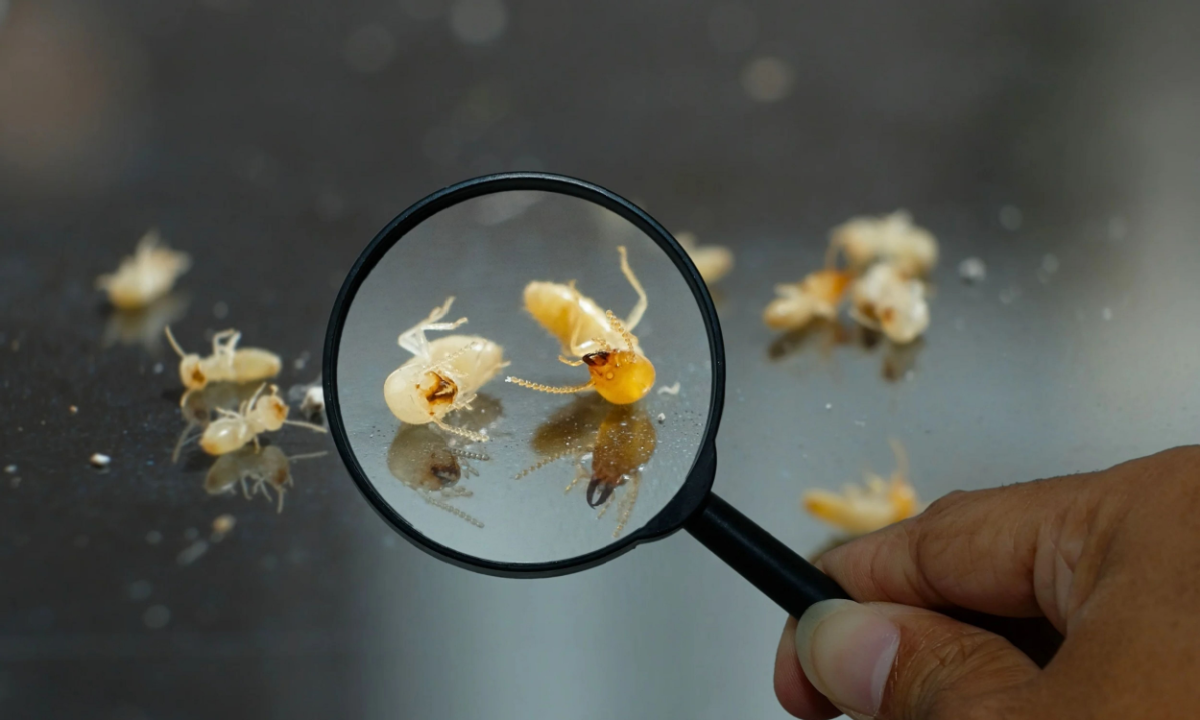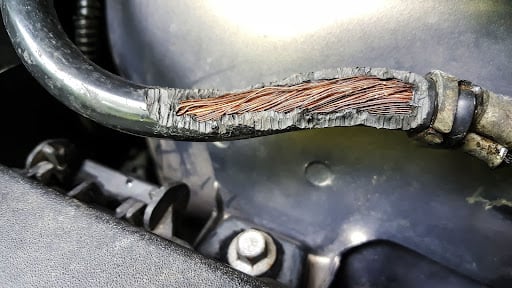Pincher bugs in your New Jersey, PA, or NY basement? Earwigs in your office? Whichever name you call them by, these pesky little insects are known for their menacing appearance and sizable claws protruding from their abdomens.
But are these insects actually dangerous, or are their pinchers all for show?
In this article, we’ll deeply dive into Earwig entomology, answering all your burning questions like: what are they? And how do you get rid of them?Request a Free, No-Obligation Quote
Request a Free, No-Obligation Quote
What Are Pincher Bugs?
The title “Pincher Bug” is a colloquial nickname given to the insect due to its frightening biology. Each pincher bug features a large pair of forceps-like cerci at the base of the abdomen.
Scientifically, Pincher Bugs are called Earwigs; these insects make up the order Dermaptera, meaning “skin wings.” Yes, Earwigs possess wings–and yes, they can fly.
However, pincher bugs generally choose to stay grounded. While most Earwigs sport a pair of large, ornate, foldable wings, they’re incredibly clumsy fliers. If you ever spot one gliding, it’s likely only doing so to migrate back to the ground after inadvertently stumbling too far up a tree or building.
Fortunately, many earwigs are nocturnal, so you’ll rarely spot one, even if it is in your yard.
You can easily identify a pincher bug by its slender 5 to 25-mm long body, long antennae, six legs, and unmistakable cerci. For this reason, spotting a pincher bug can cause alarm, but should it be?
Signs of a Pincher Bug Infestation
Due to their moderate size and threatening appearance, the sight of a few pincher bugs in your home may cause hysteria among the family.
Luckily, Pincher Bug infestations are considerably rare.
Pincher Bugs are not social, unlike bees or termites who reside in a colony. In fact, they travel individually, preferring to hide in cracks, crevices, or outdoors in damp soil rich with vegetation.
Unless the conditions inside your home are perfect, like a wet basement or poorly insulated/sealed laundry room, you likely won’t see these insects in large numbers.
When Do Pincher Bugs Come Around?
Pincher Bug season begins approximately late Spring or early Summer. During this time, they’re typically most active, navigating through gardens and moist soil in search of fresh vegetation. However, once the cold Winter months settle in, the insect’s populations dwindle, and the remaining individuals migrate underground.
Are Pincher Bugs Dangerous?
While Pincher Bugs may look menacing, they’re entirely harmless to humans. So in the rare event that you find yourself on the receiving end of a pinch, you’ll likely feel nothing more than a slight, painless pressure.
Thankfully, earwigs are completely non-venomous since their pincers don’t produce toxins and rarely break the skin. Besides their cerci, Pincher Bugs can also secrete a foul-smelling liquid from their abdomens when threatened; however, this is yet another harmless defense mechanism.
Request a Free, No-Obligation Quote
7 Ways to Get Rid of Pincher Bugs
As mentioned previously, Pincher Bugs rarely infest a space, making removal and prevention a breeze. However, for the few insects that always manage to find a way into your home, try these seven simple methods for removal.
1. Vacuum them Up!
Your household vacuum cleaner can be an excellent tool for eradicating pests and eggs; simply suck them up and dump the vacuum’s contents into a sealed container or bucket of soapy water!
Alternatively, you can employ the nylon stocking method. Cut the leg off a nylon stocking, insert the closed portion into your vacuum cleaner’s hose, and secure the open end with a rubber band. Now suck up the insects as before! When finished, quickly remove the stocking, tie off the open end, and dispose of the insects.
2. Boric Acid
Purchasable at most hardware stores, boric acid is an effective natural insecticide that kills Earwigs on contact. Sprinkle the powder over areas with high pest traffic, including entrances and feeding areas, and let it do the work for you!
3. Use an Insecticide
Insecticides are often used as a last resort due to the toxic nature of the active ingredients. Nevertheless, they’re incredibly effective at killing Earwigs on contact. Always be mindful when using the chemicals around pets and small children, and follow the manufacturer’s instructions closely.
4. Dish Soap and Water
A mixture of dish soap and water can be a safer alternative to insecticides. Spray the concoction on plants and other areas where you’ve regularly noted Pincher Bugs’ presence.
Alternatively, you may construct a simple trap using a similar solution. Fill a bowl with a solution of water and a few drops of dish soap; shining a light on the solution can also help to attract the insects. When an Earwig climbs the tub and falls into the solution, they’ll quickly drown.
5. Use Rubbing Alcohol
Mix a 50/50 solution of rubbing alcohol and water in a spray bottle. Liberally spray the contents around high-traffic zones and directly onto any live insects—the rubbing alcohol solution should penetrate the Earwig’s waxy exoskeleton, causing death.
6. Apply a Barrier Treatment
Applying an insecticide insect barrier can be an excellent alternative to using contact-killing pesticides in the house. These chemical solutions are applied around common entry points around your home and repel insects, keeping your home Pincher Bug free!
7. Contact an Exterminator
If you are still waiting for your desired results, contact your qualified local pest experts at Anchor Pest Control. With over 25 years of experience under our belts, we’d be happy to provide you with the tools and services required to rid your home of Earwigs.
Tips for Prevention
As with most pest infestations, it’s vital to tackle the problem at its root cause rather than repeatedly addressing the symptoms. Therefore, this section will focus on the best forms of Pincher Bug prevention.
Remove Excess Moisture
Pincher Bugs thrive in damp environments, so it’s often helpful to dry out the soil around your home. Ensure gutters are clear and adequately draining away from your home’s foundation, preventing excess water buildup.
Additionally, resolve any leaking plumbing or ventilating issues that may be causing any excess moisture indoors.
Eliminate Hiding Places
Loose leaf piles or overgrown shrubbery around your yard? These are ideal places for Pincher Bugs to hide out. Try eliminating any hiding places to permanently cast insects out of your yard and away from your home.
Seal Potential Entry Points
Pincher Bugs can squeeze through even the tightest gaps in siding or drafty windows with their slender bodies. Using the appropriate latex caulking, seal up any holes or cracks around your home and repair any torn or damaged window screens.
Takeaways
So, are pincher bugs as frightening as they look? Like most insects, no. While these non-venomous pests can pinch, it typically isn’t painful.
Pincher Bugs don’t reside in colonies, unlike other pests, making their presence in high numbers extremely rare. If you find them indoors, they’re likely individuals searching for food, shelter, and water. Luckily, by following the seven tips listed above, you’ll have a Pincher Bug-free home in no time!
How to Get Rid of Pincher Bugs: FAQ
What’s the proper name for a Pincher Bug?
While commonly referred to by this colloquial nickname due to the insect’s large, forceps-like cerci, the proper title for a “Pincher Bug” is Earwig.
Can Pincher Bugs pinch?
The cerci at the base of a Pincher Bug’s abdomen aren’t just for show; Pincher Bugs use these appendages to fend off potential threats and capture living prey in some species. However, pincher bugs rarely set their hindquarters on humans. If they do, you’ll likely experience nothing more than a slight pressure.
Are Pincher Bug Infestations Common?
Pincher bugs aren’t social insects, meaning they don’t reside in a nest or colony like carpenter ants or bees; instead, they prefer to travel individually. As a result, it’s rare for infestations to take place. Household infestations require perfect conditions, such as high moisture levels, easy access to vegetation, and plenty of hiding places.Request a Free, No-Obligation Quote




